BSBSUS501: Creating Workplace Sustainability Policy and Procedures
VerifiedAdded on 2023/06/18
|60
|12651
|306
Homework Assignment
AI Summary
This document presents a comprehensive learner workbook for BSBSUS501: Develop workplace policy and procedures for sustainability. It includes detailed instructions for learners and assessors, covering various activities designed to assess the learner's understanding and application of sustainability principles in a workplace context. The workbook contains activities ranging from identifying sustainability issues and developing policy options to implementing and monitoring sustainability procedures. It also incorporates checklists for assessors to evaluate learner performance in each activity, along with summative assessments covering skills, knowledge, and performance. Supplementary oral questions and a competency record are provided for further evaluation. The overall aim is to equip learners with the skills and knowledge necessary to create and implement effective sustainability policies within their workplace.
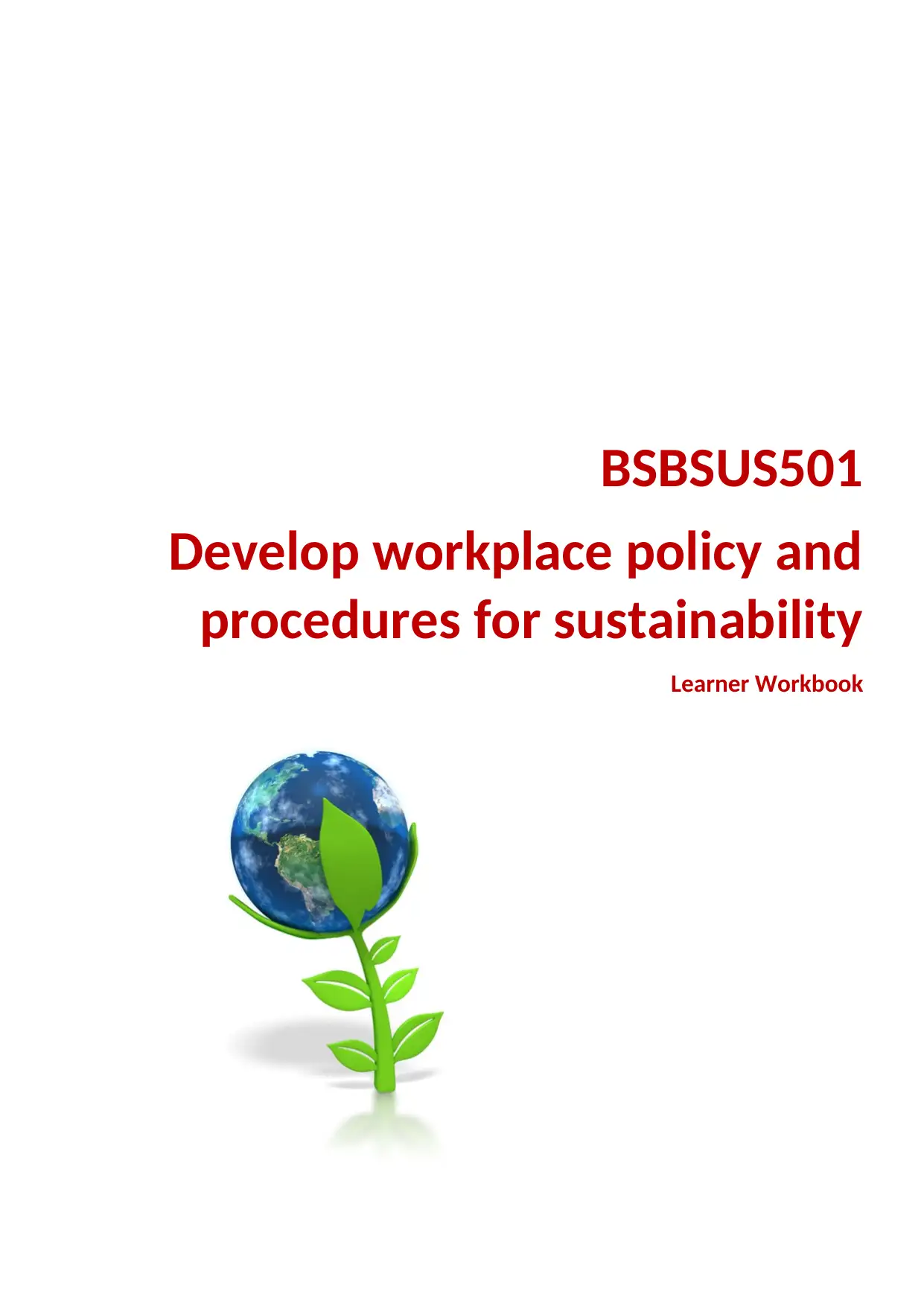
BSBSUS501
Develop workplace policy and
procedures for sustainability
Learner Workbook
Develop workplace policy and
procedures for sustainability
Learner Workbook
Paraphrase This Document
Need a fresh take? Get an instant paraphrase of this document with our AI Paraphraser
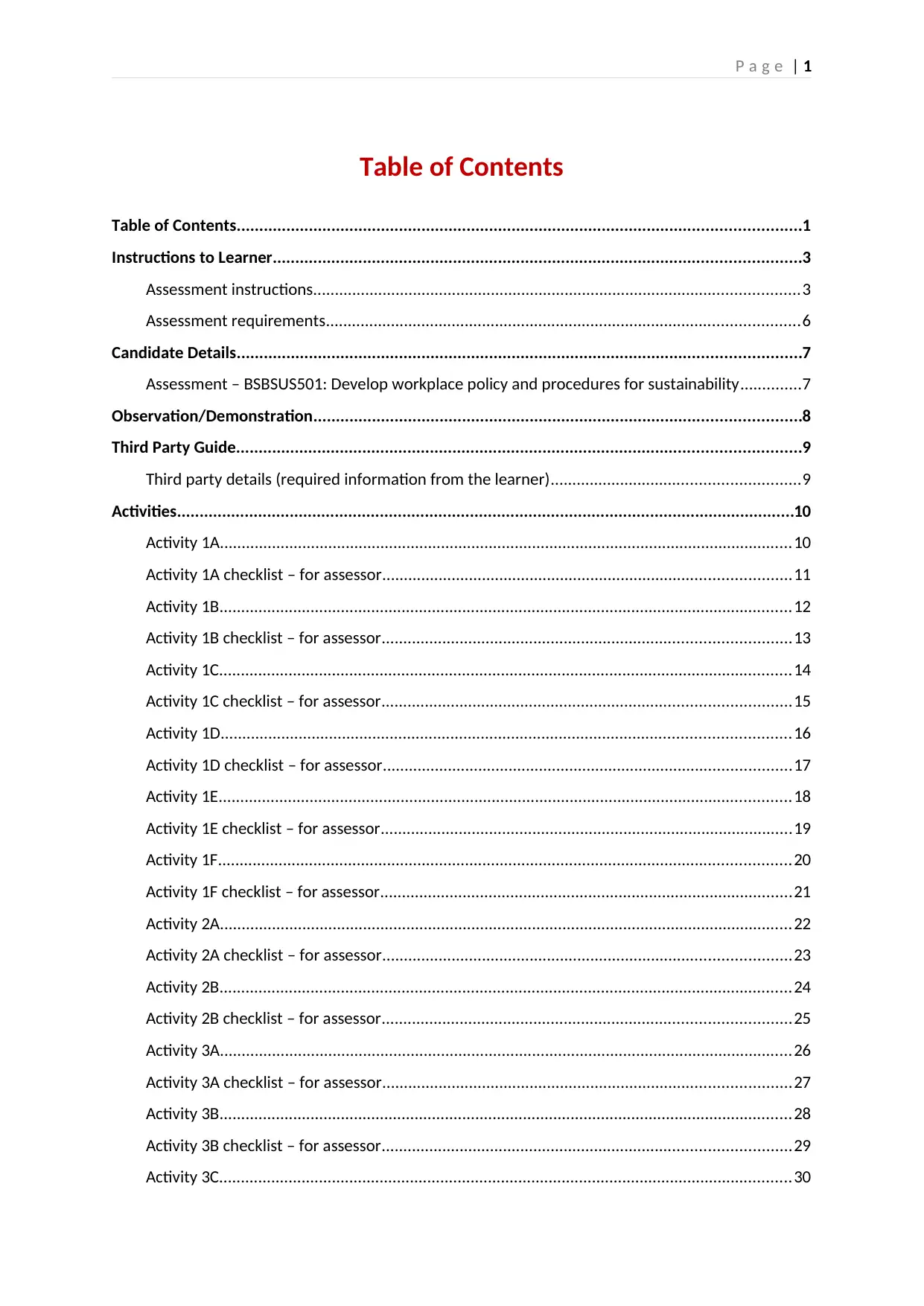
P a g e | 1
Table of Contents
Table of Contents.............................................................................................................................1
Instructions to Learner.....................................................................................................................3
Assessment instructions................................................................................................................3
Assessment requirements.............................................................................................................6
Candidate Details.............................................................................................................................7
Assessment – BSBSUS501: Develop workplace policy and procedures for sustainability..............7
Observation/Demonstration............................................................................................................8
Third Party Guide.............................................................................................................................9
Third party details (required information from the learner).........................................................9
Activities.........................................................................................................................................10
Activity 1A....................................................................................................................................10
Activity 1A checklist – for assessor..............................................................................................11
Activity 1B....................................................................................................................................12
Activity 1B checklist – for assessor..............................................................................................13
Activity 1C....................................................................................................................................14
Activity 1C checklist – for assessor..............................................................................................15
Activity 1D...................................................................................................................................16
Activity 1D checklist – for assessor..............................................................................................17
Activity 1E....................................................................................................................................18
Activity 1E checklist – for assessor...............................................................................................19
Activity 1F....................................................................................................................................20
Activity 1F checklist – for assessor...............................................................................................21
Activity 2A....................................................................................................................................22
Activity 2A checklist – for assessor..............................................................................................23
Activity 2B....................................................................................................................................24
Activity 2B checklist – for assessor..............................................................................................25
Activity 3A....................................................................................................................................26
Activity 3A checklist – for assessor..............................................................................................27
Activity 3B....................................................................................................................................28
Activity 3B checklist – for assessor..............................................................................................29
Activity 3C....................................................................................................................................30
Table of Contents
Table of Contents.............................................................................................................................1
Instructions to Learner.....................................................................................................................3
Assessment instructions................................................................................................................3
Assessment requirements.............................................................................................................6
Candidate Details.............................................................................................................................7
Assessment – BSBSUS501: Develop workplace policy and procedures for sustainability..............7
Observation/Demonstration............................................................................................................8
Third Party Guide.............................................................................................................................9
Third party details (required information from the learner).........................................................9
Activities.........................................................................................................................................10
Activity 1A....................................................................................................................................10
Activity 1A checklist – for assessor..............................................................................................11
Activity 1B....................................................................................................................................12
Activity 1B checklist – for assessor..............................................................................................13
Activity 1C....................................................................................................................................14
Activity 1C checklist – for assessor..............................................................................................15
Activity 1D...................................................................................................................................16
Activity 1D checklist – for assessor..............................................................................................17
Activity 1E....................................................................................................................................18
Activity 1E checklist – for assessor...............................................................................................19
Activity 1F....................................................................................................................................20
Activity 1F checklist – for assessor...............................................................................................21
Activity 2A....................................................................................................................................22
Activity 2A checklist – for assessor..............................................................................................23
Activity 2B....................................................................................................................................24
Activity 2B checklist – for assessor..............................................................................................25
Activity 3A....................................................................................................................................26
Activity 3A checklist – for assessor..............................................................................................27
Activity 3B....................................................................................................................................28
Activity 3B checklist – for assessor..............................................................................................29
Activity 3C....................................................................................................................................30
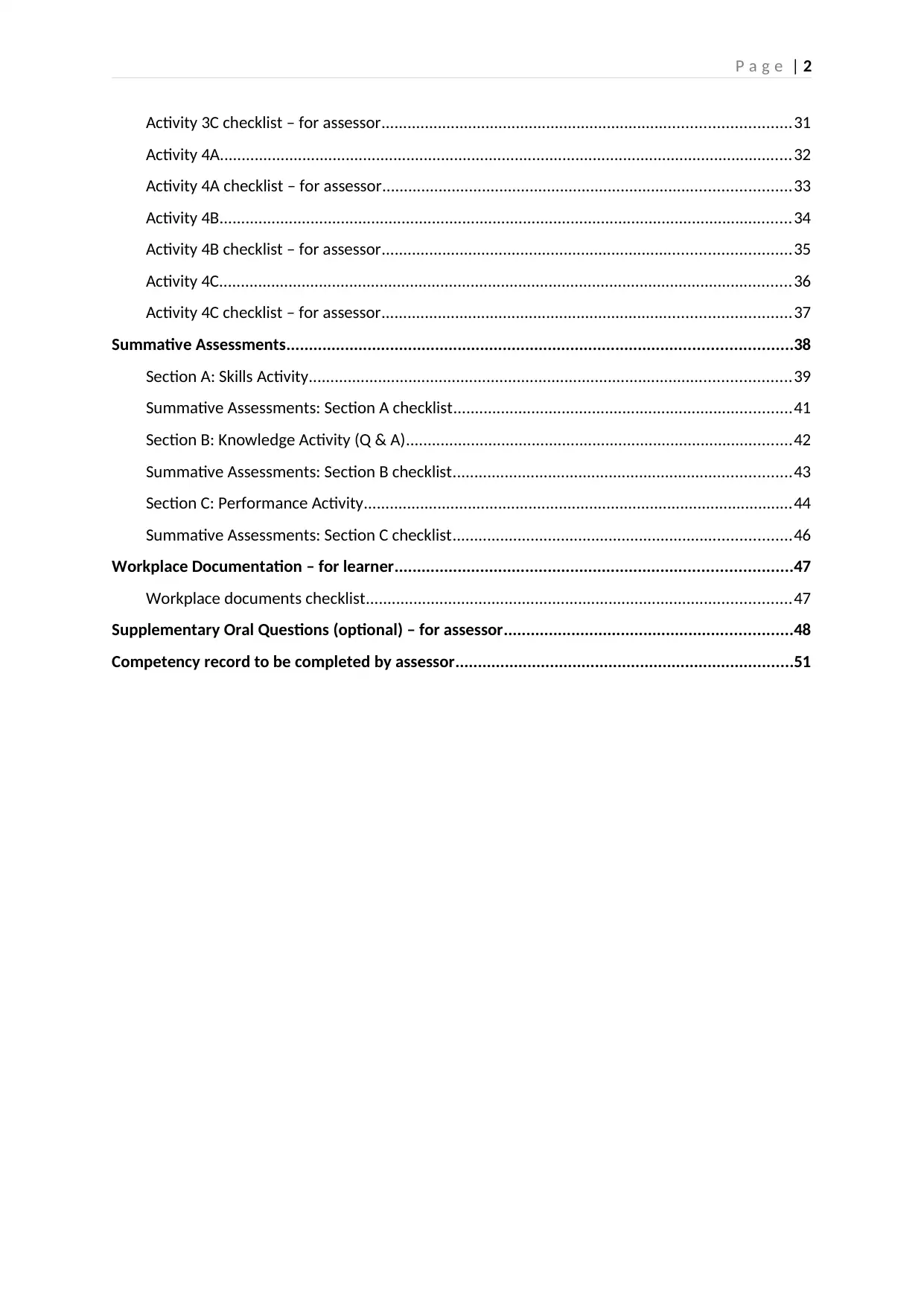
P a g e | 2
Activity 3C checklist – for assessor..............................................................................................31
Activity 4A....................................................................................................................................32
Activity 4A checklist – for assessor..............................................................................................33
Activity 4B....................................................................................................................................34
Activity 4B checklist – for assessor..............................................................................................35
Activity 4C....................................................................................................................................36
Activity 4C checklist – for assessor..............................................................................................37
Summative Assessments................................................................................................................38
Section A: Skills Activity...............................................................................................................39
Summative Assessments: Section A checklist..............................................................................41
Section B: Knowledge Activity (Q & A).........................................................................................42
Summative Assessments: Section B checklist..............................................................................43
Section C: Performance Activity...................................................................................................44
Summative Assessments: Section C checklist..............................................................................46
Workplace Documentation – for learner........................................................................................47
Workplace documents checklist..................................................................................................47
Supplementary Oral Questions (optional) – for assessor................................................................48
Competency record to be completed by assessor...........................................................................51
Activity 3C checklist – for assessor..............................................................................................31
Activity 4A....................................................................................................................................32
Activity 4A checklist – for assessor..............................................................................................33
Activity 4B....................................................................................................................................34
Activity 4B checklist – for assessor..............................................................................................35
Activity 4C....................................................................................................................................36
Activity 4C checklist – for assessor..............................................................................................37
Summative Assessments................................................................................................................38
Section A: Skills Activity...............................................................................................................39
Summative Assessments: Section A checklist..............................................................................41
Section B: Knowledge Activity (Q & A).........................................................................................42
Summative Assessments: Section B checklist..............................................................................43
Section C: Performance Activity...................................................................................................44
Summative Assessments: Section C checklist..............................................................................46
Workplace Documentation – for learner........................................................................................47
Workplace documents checklist..................................................................................................47
Supplementary Oral Questions (optional) – for assessor................................................................48
Competency record to be completed by assessor...........................................................................51
⊘ This is a preview!⊘
Do you want full access?
Subscribe today to unlock all pages.

Trusted by 1+ million students worldwide

P a g e | 3
Instructions to Learner
Assessment instructions
Overview
Prior to commencing the assessments, your trainer/assessor will explain each assessment task and
the terms and conditions relating to the submission of your assessment task. Please consult with
your trainer/assessor if you are unsure of any questions. It is important that you understand and
adhere to the terms and conditions, and address fully each assessment task. If any assessment task
is not fully addressed, then your assessment task will be returned to you for resubmission. Your
trainer/assessor will remain available to support you throughout the assessment process.
Written work
Assessment tasks are used to measure your understanding and underpinning skills and knowledge of
the overall unit of competency. When undertaking any written assessment tasks, please ensure that
you address the following criteria:
Address each question including any sub-points
Demonstrate that you have researched the topic thoroughly
Cover the topic in a logical, structured manner
Your assessment tasks are well presented, well referenced and word processed
Your assessment tasks include your full legal name on each and every page.
Active participation
It is a condition of enrolment that you actively participate in your studies. Active participation is
completing all the assessment tasks on time.
Plagiarism
Plagiarism is taking and using someone else's thoughts, writings or inventions and representing them
as your own. Plagiarism is a serious act and may result in a learner’s exclusion from a course. When
you have any doubts about including the work of other authors in your assessment, please consult
your trainer/assessor. The following list outlines some of the activities for which a learner can be
accused of plagiarism:
Presenting any work by another individual as one's own unintentionally
Handing in assessments markedly similar to or copied from another learner
Presenting the work of another individual or group as their own work
Handing in assessments without the adequate acknowledgement of sources used, including
assessments taken totally or in part from the internet.
Instructions to Learner
Assessment instructions
Overview
Prior to commencing the assessments, your trainer/assessor will explain each assessment task and
the terms and conditions relating to the submission of your assessment task. Please consult with
your trainer/assessor if you are unsure of any questions. It is important that you understand and
adhere to the terms and conditions, and address fully each assessment task. If any assessment task
is not fully addressed, then your assessment task will be returned to you for resubmission. Your
trainer/assessor will remain available to support you throughout the assessment process.
Written work
Assessment tasks are used to measure your understanding and underpinning skills and knowledge of
the overall unit of competency. When undertaking any written assessment tasks, please ensure that
you address the following criteria:
Address each question including any sub-points
Demonstrate that you have researched the topic thoroughly
Cover the topic in a logical, structured manner
Your assessment tasks are well presented, well referenced and word processed
Your assessment tasks include your full legal name on each and every page.
Active participation
It is a condition of enrolment that you actively participate in your studies. Active participation is
completing all the assessment tasks on time.
Plagiarism
Plagiarism is taking and using someone else's thoughts, writings or inventions and representing them
as your own. Plagiarism is a serious act and may result in a learner’s exclusion from a course. When
you have any doubts about including the work of other authors in your assessment, please consult
your trainer/assessor. The following list outlines some of the activities for which a learner can be
accused of plagiarism:
Presenting any work by another individual as one's own unintentionally
Handing in assessments markedly similar to or copied from another learner
Presenting the work of another individual or group as their own work
Handing in assessments without the adequate acknowledgement of sources used, including
assessments taken totally or in part from the internet.
Paraphrase This Document
Need a fresh take? Get an instant paraphrase of this document with our AI Paraphraser
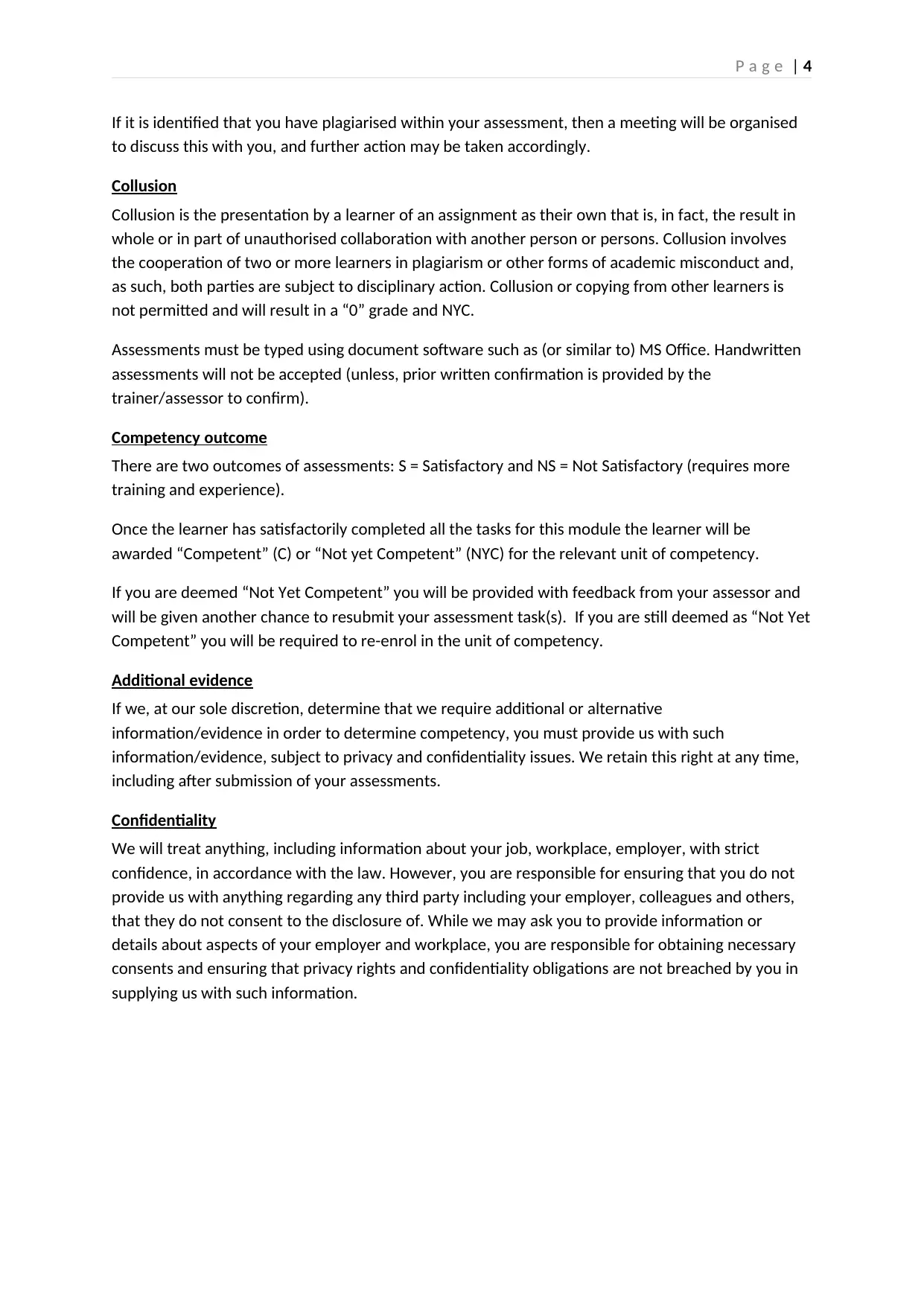
P a g e | 4
If it is identified that you have plagiarised within your assessment, then a meeting will be organised
to discuss this with you, and further action may be taken accordingly.
Collusion
Collusion is the presentation by a learner of an assignment as their own that is, in fact, the result in
whole or in part of unauthorised collaboration with another person or persons. Collusion involves
the cooperation of two or more learners in plagiarism or other forms of academic misconduct and,
as such, both parties are subject to disciplinary action. Collusion or copying from other learners is
not permitted and will result in a “0” grade and NYC.
Assessments must be typed using document software such as (or similar to) MS Office. Handwritten
assessments will not be accepted (unless, prior written confirmation is provided by the
trainer/assessor to confirm).
Competency outcome
There are two outcomes of assessments: S = Satisfactory and NS = Not Satisfactory (requires more
training and experience).
Once the learner has satisfactorily completed all the tasks for this module the learner will be
awarded “Competent” (C) or “Not yet Competent” (NYC) for the relevant unit of competency.
If you are deemed “Not Yet Competent” you will be provided with feedback from your assessor and
will be given another chance to resubmit your assessment task(s). If you are still deemed as “Not Yet
Competent” you will be required to re-enrol in the unit of competency.
Additional evidence
If we, at our sole discretion, determine that we require additional or alternative
information/evidence in order to determine competency, you must provide us with such
information/evidence, subject to privacy and confidentiality issues. We retain this right at any time,
including after submission of your assessments.
Confidentiality
We will treat anything, including information about your job, workplace, employer, with strict
confidence, in accordance with the law. However, you are responsible for ensuring that you do not
provide us with anything regarding any third party including your employer, colleagues and others,
that they do not consent to the disclosure of. While we may ask you to provide information or
details about aspects of your employer and workplace, you are responsible for obtaining necessary
consents and ensuring that privacy rights and confidentiality obligations are not breached by you in
supplying us with such information.
If it is identified that you have plagiarised within your assessment, then a meeting will be organised
to discuss this with you, and further action may be taken accordingly.
Collusion
Collusion is the presentation by a learner of an assignment as their own that is, in fact, the result in
whole or in part of unauthorised collaboration with another person or persons. Collusion involves
the cooperation of two or more learners in plagiarism or other forms of academic misconduct and,
as such, both parties are subject to disciplinary action. Collusion or copying from other learners is
not permitted and will result in a “0” grade and NYC.
Assessments must be typed using document software such as (or similar to) MS Office. Handwritten
assessments will not be accepted (unless, prior written confirmation is provided by the
trainer/assessor to confirm).
Competency outcome
There are two outcomes of assessments: S = Satisfactory and NS = Not Satisfactory (requires more
training and experience).
Once the learner has satisfactorily completed all the tasks for this module the learner will be
awarded “Competent” (C) or “Not yet Competent” (NYC) for the relevant unit of competency.
If you are deemed “Not Yet Competent” you will be provided with feedback from your assessor and
will be given another chance to resubmit your assessment task(s). If you are still deemed as “Not Yet
Competent” you will be required to re-enrol in the unit of competency.
Additional evidence
If we, at our sole discretion, determine that we require additional or alternative
information/evidence in order to determine competency, you must provide us with such
information/evidence, subject to privacy and confidentiality issues. We retain this right at any time,
including after submission of your assessments.
Confidentiality
We will treat anything, including information about your job, workplace, employer, with strict
confidence, in accordance with the law. However, you are responsible for ensuring that you do not
provide us with anything regarding any third party including your employer, colleagues and others,
that they do not consent to the disclosure of. While we may ask you to provide information or
details about aspects of your employer and workplace, you are responsible for obtaining necessary
consents and ensuring that privacy rights and confidentiality obligations are not breached by you in
supplying us with such information.

P a g e | 5
Assessment appeals process
If you feel that you have been unfairly treated during your assessment, and you are not happy with
your assessment and/or the outcome as a result of that treatment, you have the right to lodge an
appeal. You must first discuss the issue with your trainer/assessor. If you would like to proceed
further with the request after discussions with your trainer/assessor, you need to lodge your appeal
to the course coordinator, in writing, outlining the reason(s) for the appeal.
Recognised prior learning
Candidates will be able to have their previous experience or expertise recognised on request.
Special needs
Candidates with special needs should notify their trainer/assessor to request any required
adjustments as soon as possible. This will enable the trainer/assessor to address the identified needs
immediately .
Assessment appeals process
If you feel that you have been unfairly treated during your assessment, and you are not happy with
your assessment and/or the outcome as a result of that treatment, you have the right to lodge an
appeal. You must first discuss the issue with your trainer/assessor. If you would like to proceed
further with the request after discussions with your trainer/assessor, you need to lodge your appeal
to the course coordinator, in writing, outlining the reason(s) for the appeal.
Recognised prior learning
Candidates will be able to have their previous experience or expertise recognised on request.
Special needs
Candidates with special needs should notify their trainer/assessor to request any required
adjustments as soon as possible. This will enable the trainer/assessor to address the identified needs
immediately .
⊘ This is a preview!⊘
Do you want full access?
Subscribe today to unlock all pages.

Trusted by 1+ million students worldwide
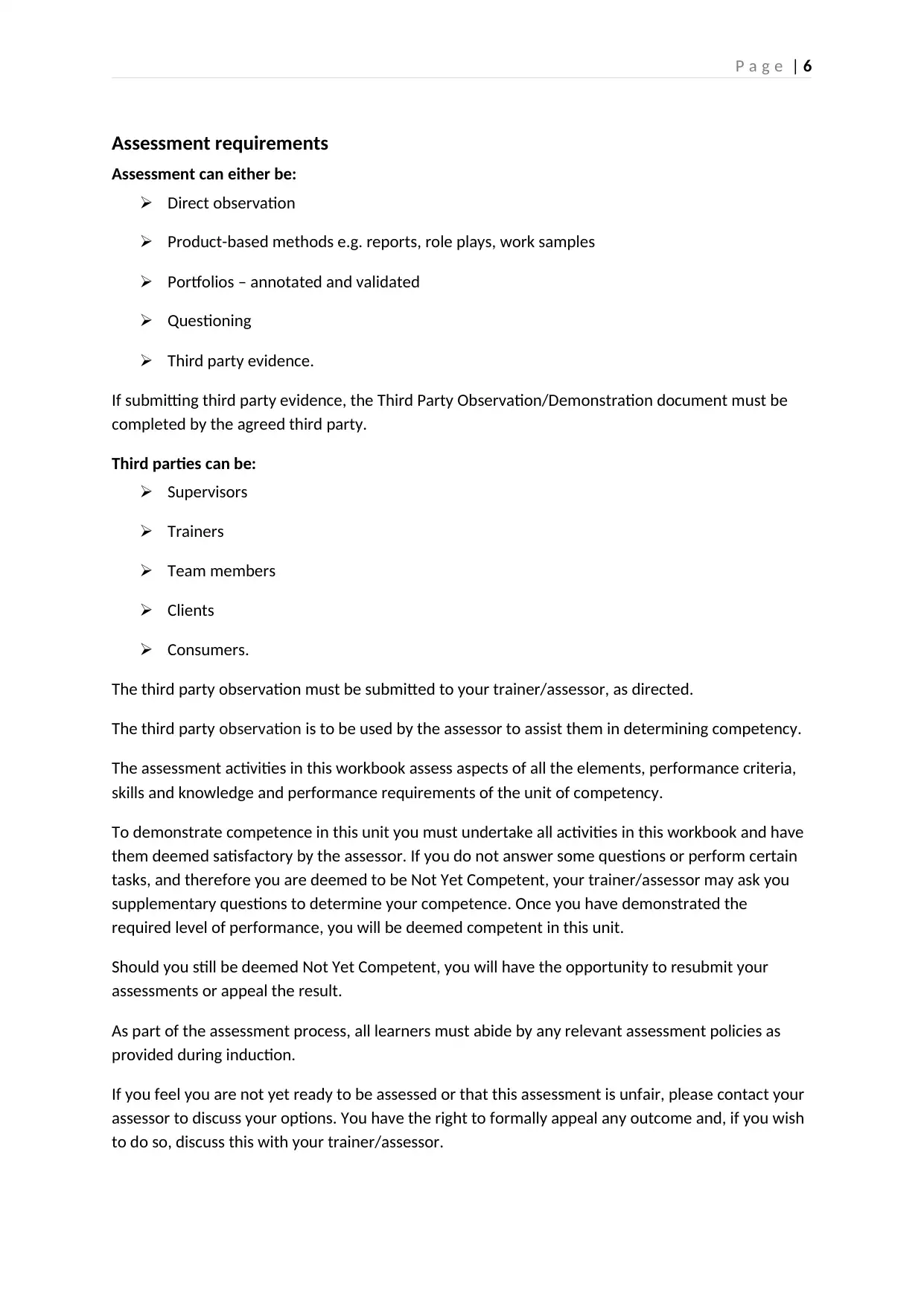
P a g e | 6
Assessment requirements
Assessment can either be:
Direct observation
Product-based methods e.g. reports, role plays, work samples
Portfolios – annotated and validated
Questioning
Third party evidence.
If submitting third party evidence, the Third Party Observation/Demonstration document must be
completed by the agreed third party.
Third parties can be:
Supervisors
Trainers
Team members
Clients
Consumers.
The third party observation must be submitted to your trainer/assessor, as directed.
The third party observation is to be used by the assessor to assist them in determining competency.
The assessment activities in this workbook assess aspects of all the elements, performance criteria,
skills and knowledge and performance requirements of the unit of competency.
To demonstrate competence in this unit you must undertake all activities in this workbook and have
them deemed satisfactory by the assessor. If you do not answer some questions or perform certain
tasks, and therefore you are deemed to be Not Yet Competent, your trainer/assessor may ask you
supplementary questions to determine your competence. Once you have demonstrated the
required level of performance, you will be deemed competent in this unit.
Should you still be deemed Not Yet Competent, you will have the opportunity to resubmit your
assessments or appeal the result.
As part of the assessment process, all learners must abide by any relevant assessment policies as
provided during induction.
If you feel you are not yet ready to be assessed or that this assessment is unfair, please contact your
assessor to discuss your options. You have the right to formally appeal any outcome and, if you wish
to do so, discuss this with your trainer/assessor.
Assessment requirements
Assessment can either be:
Direct observation
Product-based methods e.g. reports, role plays, work samples
Portfolios – annotated and validated
Questioning
Third party evidence.
If submitting third party evidence, the Third Party Observation/Demonstration document must be
completed by the agreed third party.
Third parties can be:
Supervisors
Trainers
Team members
Clients
Consumers.
The third party observation must be submitted to your trainer/assessor, as directed.
The third party observation is to be used by the assessor to assist them in determining competency.
The assessment activities in this workbook assess aspects of all the elements, performance criteria,
skills and knowledge and performance requirements of the unit of competency.
To demonstrate competence in this unit you must undertake all activities in this workbook and have
them deemed satisfactory by the assessor. If you do not answer some questions or perform certain
tasks, and therefore you are deemed to be Not Yet Competent, your trainer/assessor may ask you
supplementary questions to determine your competence. Once you have demonstrated the
required level of performance, you will be deemed competent in this unit.
Should you still be deemed Not Yet Competent, you will have the opportunity to resubmit your
assessments or appeal the result.
As part of the assessment process, all learners must abide by any relevant assessment policies as
provided during induction.
If you feel you are not yet ready to be assessed or that this assessment is unfair, please contact your
assessor to discuss your options. You have the right to formally appeal any outcome and, if you wish
to do so, discuss this with your trainer/assessor.
Paraphrase This Document
Need a fresh take? Get an instant paraphrase of this document with our AI Paraphraser

P a g e | 7
Candidate Details
Assessment – BSBSUS501: Develop workplace policy and procedures for
sustainability
Please complete the following activities and hand in to your trainer/assessor for marking. This forms
part of your assessment for BSBSUS501: Develop workplace policy and procedures for sustainability.
Name: _____________________________________________________________
Address: _____________________________________________________________
_____________________________________________________________
Email: _____________________________________________________________
Employer: _____________________________________________________________
Declaration
I declare that no part of this assessment has been copied from another person’s work with the
exception of where I have listed or referenced documents or work and that no part of this
assessment has been written for me by another person. I also understand the assessment
instructions and requirements and consent to being assessed.
Signed: ____________________________________________________________
Date: ____________________________________________________________
If activities have been completed as part of a small group or in pairs, details of the learners
involved should be provided below:
This activity workbook has been completed by the following persons and we acknowledge that it
was a fair team effort where everyone contributed equally to the work completed. We declare that
no part of this assessment has been copied from another person’s work with the exception of where
we have listed or referenced documents or work and that no part of this assessment has been
written for us by another person.
Learner 1: ____________________________________________________________
Signed: ____________________________________________________________
Learner 2: ____________________________________________________________
Signed: ____________________________________________________________
Learner 3: ____________________________________________________________
Signed: ____________________________________________________________
Candidate Details
Assessment – BSBSUS501: Develop workplace policy and procedures for
sustainability
Please complete the following activities and hand in to your trainer/assessor for marking. This forms
part of your assessment for BSBSUS501: Develop workplace policy and procedures for sustainability.
Name: _____________________________________________________________
Address: _____________________________________________________________
_____________________________________________________________
Email: _____________________________________________________________
Employer: _____________________________________________________________
Declaration
I declare that no part of this assessment has been copied from another person’s work with the
exception of where I have listed or referenced documents or work and that no part of this
assessment has been written for me by another person. I also understand the assessment
instructions and requirements and consent to being assessed.
Signed: ____________________________________________________________
Date: ____________________________________________________________
If activities have been completed as part of a small group or in pairs, details of the learners
involved should be provided below:
This activity workbook has been completed by the following persons and we acknowledge that it
was a fair team effort where everyone contributed equally to the work completed. We declare that
no part of this assessment has been copied from another person’s work with the exception of where
we have listed or referenced documents or work and that no part of this assessment has been
written for us by another person.
Learner 1: ____________________________________________________________
Signed: ____________________________________________________________
Learner 2: ____________________________________________________________
Signed: ____________________________________________________________
Learner 3: ____________________________________________________________
Signed: ____________________________________________________________
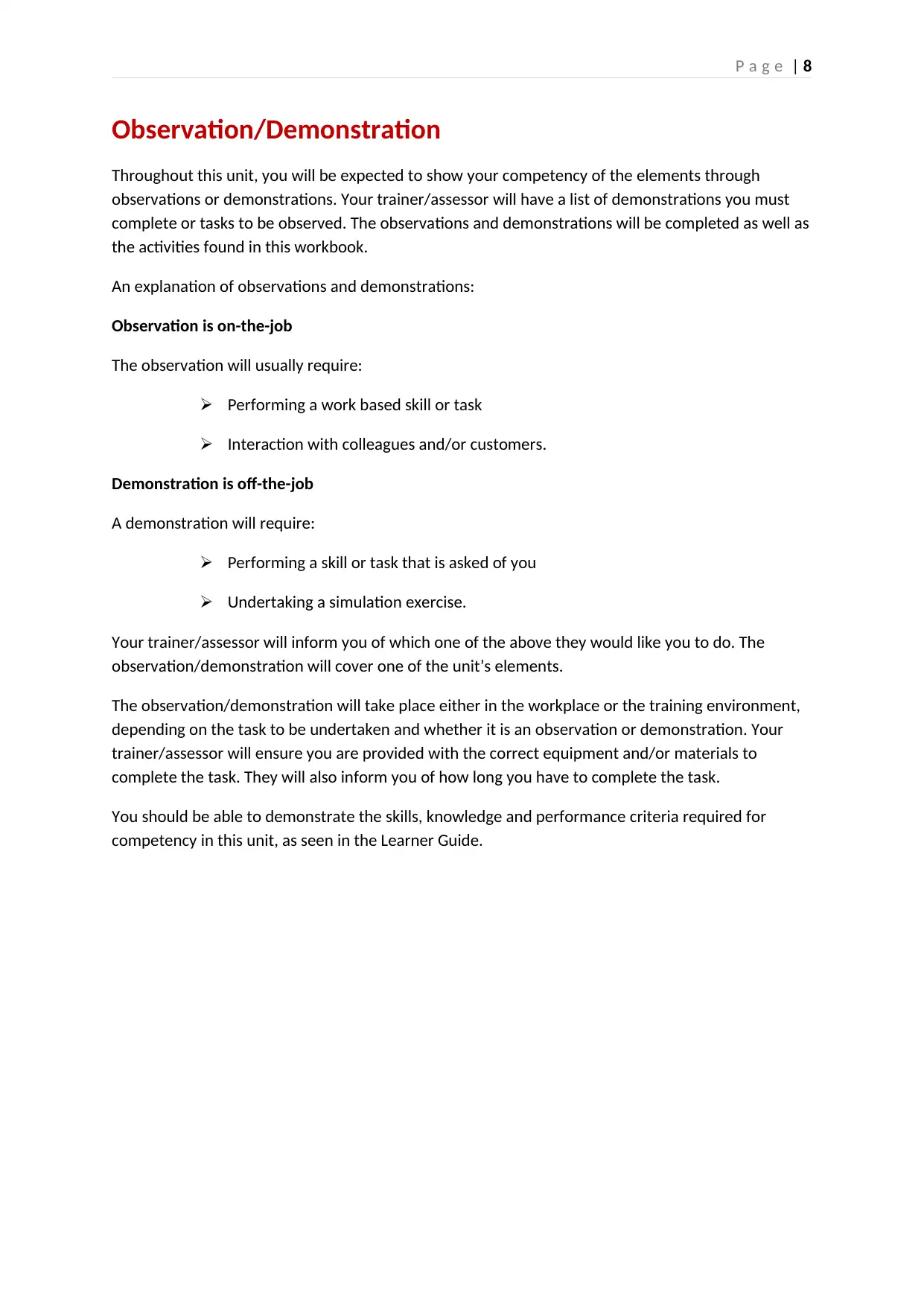
P a g e | 8
Observation/Demonstration
Throughout this unit, you will be expected to show your competency of the elements through
observations or demonstrations. Your trainer/assessor will have a list of demonstrations you must
complete or tasks to be observed. The observations and demonstrations will be completed as well as
the activities found in this workbook.
An explanation of observations and demonstrations:
Observation is on-the-job
The observation will usually require:
Performing a work based skill or task
Interaction with colleagues and/or customers.
Demonstration is off-the-job
A demonstration will require:
Performing a skill or task that is asked of you
Undertaking a simulation exercise.
Your trainer/assessor will inform you of which one of the above they would like you to do. The
observation/demonstration will cover one of the unit’s elements.
The observation/demonstration will take place either in the workplace or the training environment,
depending on the task to be undertaken and whether it is an observation or demonstration. Your
trainer/assessor will ensure you are provided with the correct equipment and/or materials to
complete the task. They will also inform you of how long you have to complete the task.
You should be able to demonstrate the skills, knowledge and performance criteria required for
competency in this unit, as seen in the Learner Guide.
Observation/Demonstration
Throughout this unit, you will be expected to show your competency of the elements through
observations or demonstrations. Your trainer/assessor will have a list of demonstrations you must
complete or tasks to be observed. The observations and demonstrations will be completed as well as
the activities found in this workbook.
An explanation of observations and demonstrations:
Observation is on-the-job
The observation will usually require:
Performing a work based skill or task
Interaction with colleagues and/or customers.
Demonstration is off-the-job
A demonstration will require:
Performing a skill or task that is asked of you
Undertaking a simulation exercise.
Your trainer/assessor will inform you of which one of the above they would like you to do. The
observation/demonstration will cover one of the unit’s elements.
The observation/demonstration will take place either in the workplace or the training environment,
depending on the task to be undertaken and whether it is an observation or demonstration. Your
trainer/assessor will ensure you are provided with the correct equipment and/or materials to
complete the task. They will also inform you of how long you have to complete the task.
You should be able to demonstrate the skills, knowledge and performance criteria required for
competency in this unit, as seen in the Learner Guide.
⊘ This is a preview!⊘
Do you want full access?
Subscribe today to unlock all pages.

Trusted by 1+ million students worldwide
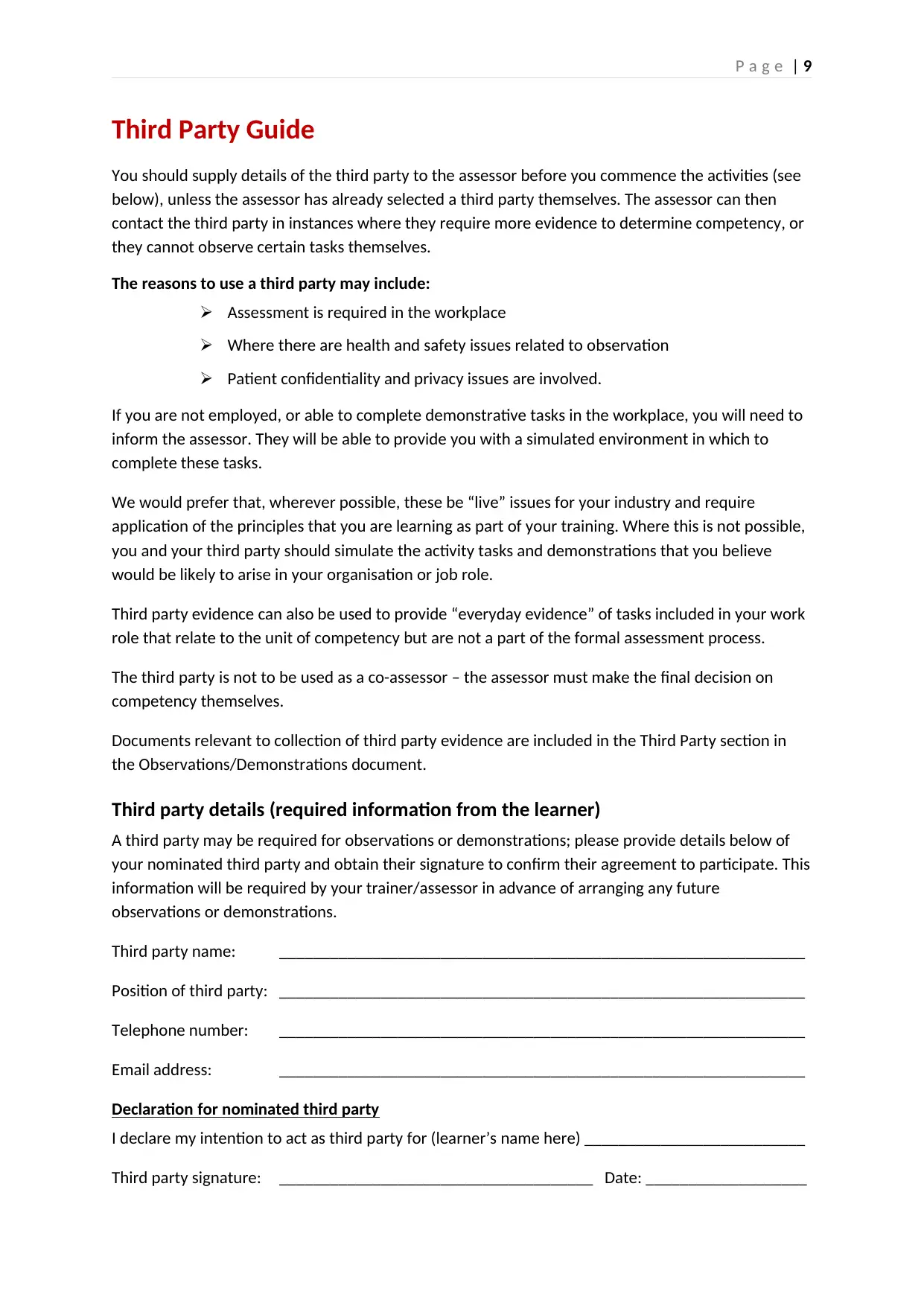
P a g e | 9
Third Party Guide
You should supply details of the third party to the assessor before you commence the activities (see
below), unless the assessor has already selected a third party themselves. The assessor can then
contact the third party in instances where they require more evidence to determine competency, or
they cannot observe certain tasks themselves.
The reasons to use a third party may include:
Assessment is required in the workplace
Where there are health and safety issues related to observation
Patient confidentiality and privacy issues are involved.
If you are not employed, or able to complete demonstrative tasks in the workplace, you will need to
inform the assessor. They will be able to provide you with a simulated environment in which to
complete these tasks.
We would prefer that, wherever possible, these be “live” issues for your industry and require
application of the principles that you are learning as part of your training. Where this is not possible,
you and your third party should simulate the activity tasks and demonstrations that you believe
would be likely to arise in your organisation or job role.
Third party evidence can also be used to provide “everyday evidence” of tasks included in your work
role that relate to the unit of competency but are not a part of the formal assessment process.
The third party is not to be used as a co-assessor – the assessor must make the final decision on
competency themselves.
Documents relevant to collection of third party evidence are included in the Third Party section in
the Observations/Demonstrations document.
Third party details (required information from the learner)
A third party may be required for observations or demonstrations; please provide details below of
your nominated third party and obtain their signature to confirm their agreement to participate. This
information will be required by your trainer/assessor in advance of arranging any future
observations or demonstrations.
Third party name: ______________________________________________________________
Position of third party: ______________________________________________________________
Telephone number: ______________________________________________________________
Email address: ______________________________________________________________
Declaration for nominated third party
I declare my intention to act as third party for (learner’s name here) __________________________
Third party signature: _____________________________________ Date: ___________________
Third Party Guide
You should supply details of the third party to the assessor before you commence the activities (see
below), unless the assessor has already selected a third party themselves. The assessor can then
contact the third party in instances where they require more evidence to determine competency, or
they cannot observe certain tasks themselves.
The reasons to use a third party may include:
Assessment is required in the workplace
Where there are health and safety issues related to observation
Patient confidentiality and privacy issues are involved.
If you are not employed, or able to complete demonstrative tasks in the workplace, you will need to
inform the assessor. They will be able to provide you with a simulated environment in which to
complete these tasks.
We would prefer that, wherever possible, these be “live” issues for your industry and require
application of the principles that you are learning as part of your training. Where this is not possible,
you and your third party should simulate the activity tasks and demonstrations that you believe
would be likely to arise in your organisation or job role.
Third party evidence can also be used to provide “everyday evidence” of tasks included in your work
role that relate to the unit of competency but are not a part of the formal assessment process.
The third party is not to be used as a co-assessor – the assessor must make the final decision on
competency themselves.
Documents relevant to collection of third party evidence are included in the Third Party section in
the Observations/Demonstrations document.
Third party details (required information from the learner)
A third party may be required for observations or demonstrations; please provide details below of
your nominated third party and obtain their signature to confirm their agreement to participate. This
information will be required by your trainer/assessor in advance of arranging any future
observations or demonstrations.
Third party name: ______________________________________________________________
Position of third party: ______________________________________________________________
Telephone number: ______________________________________________________________
Email address: ______________________________________________________________
Declaration for nominated third party
I declare my intention to act as third party for (learner’s name here) __________________________
Third party signature: _____________________________________ Date: ___________________
Paraphrase This Document
Need a fresh take? Get an instant paraphrase of this document with our AI Paraphraser
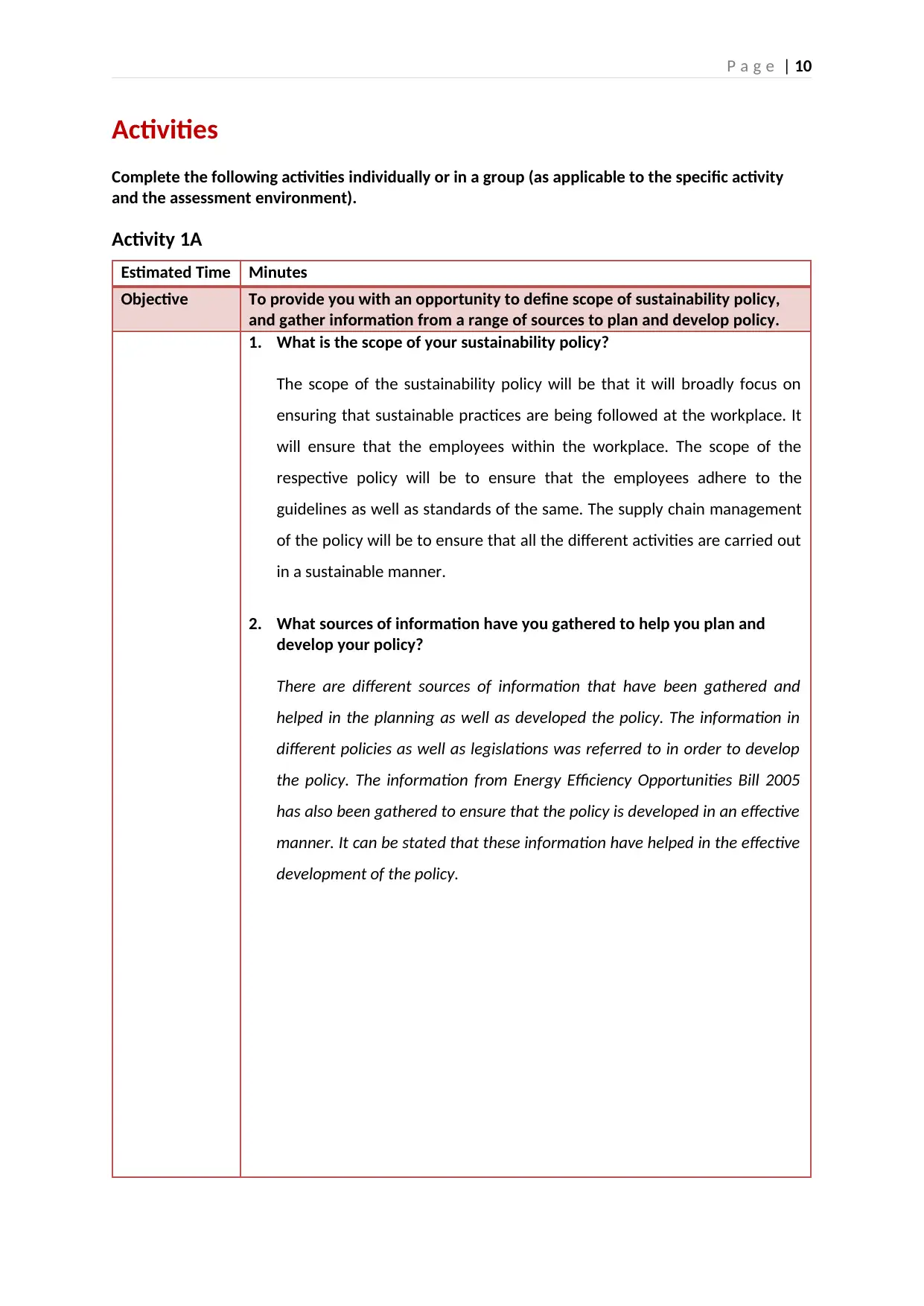
P a g e | 10
Activities
Complete the following activities individually or in a group (as applicable to the specific activity
and the assessment environment).
Activity 1A
Estimated Time Minutes
Objective To provide you with an opportunity to define scope of sustainability policy,
and gather information from a range of sources to plan and develop policy.
1. What is the scope of your sustainability policy?
The scope of the sustainability policy will be that it will broadly focus on
ensuring that sustainable practices are being followed at the workplace. It
will ensure that the employees within the workplace. The scope of the
respective policy will be to ensure that the employees adhere to the
guidelines as well as standards of the same. The supply chain management
of the policy will be to ensure that all the different activities are carried out
in a sustainable manner.
2. What sources of information have you gathered to help you plan and
develop your policy?
There are different sources of information that have been gathered and
helped in the planning as well as developed the policy. The information in
different policies as well as legislations was referred to in order to develop
the policy. The information from Energy Efficiency Opportunities Bill 2005
has also been gathered to ensure that the policy is developed in an effective
manner. It can be stated that these information have helped in the effective
development of the policy.
Activities
Complete the following activities individually or in a group (as applicable to the specific activity
and the assessment environment).
Activity 1A
Estimated Time Minutes
Objective To provide you with an opportunity to define scope of sustainability policy,
and gather information from a range of sources to plan and develop policy.
1. What is the scope of your sustainability policy?
The scope of the sustainability policy will be that it will broadly focus on
ensuring that sustainable practices are being followed at the workplace. It
will ensure that the employees within the workplace. The scope of the
respective policy will be to ensure that the employees adhere to the
guidelines as well as standards of the same. The supply chain management
of the policy will be to ensure that all the different activities are carried out
in a sustainable manner.
2. What sources of information have you gathered to help you plan and
develop your policy?
There are different sources of information that have been gathered and
helped in the planning as well as developed the policy. The information in
different policies as well as legislations was referred to in order to develop
the policy. The information from Energy Efficiency Opportunities Bill 2005
has also been gathered to ensure that the policy is developed in an effective
manner. It can be stated that these information have helped in the effective
development of the policy.
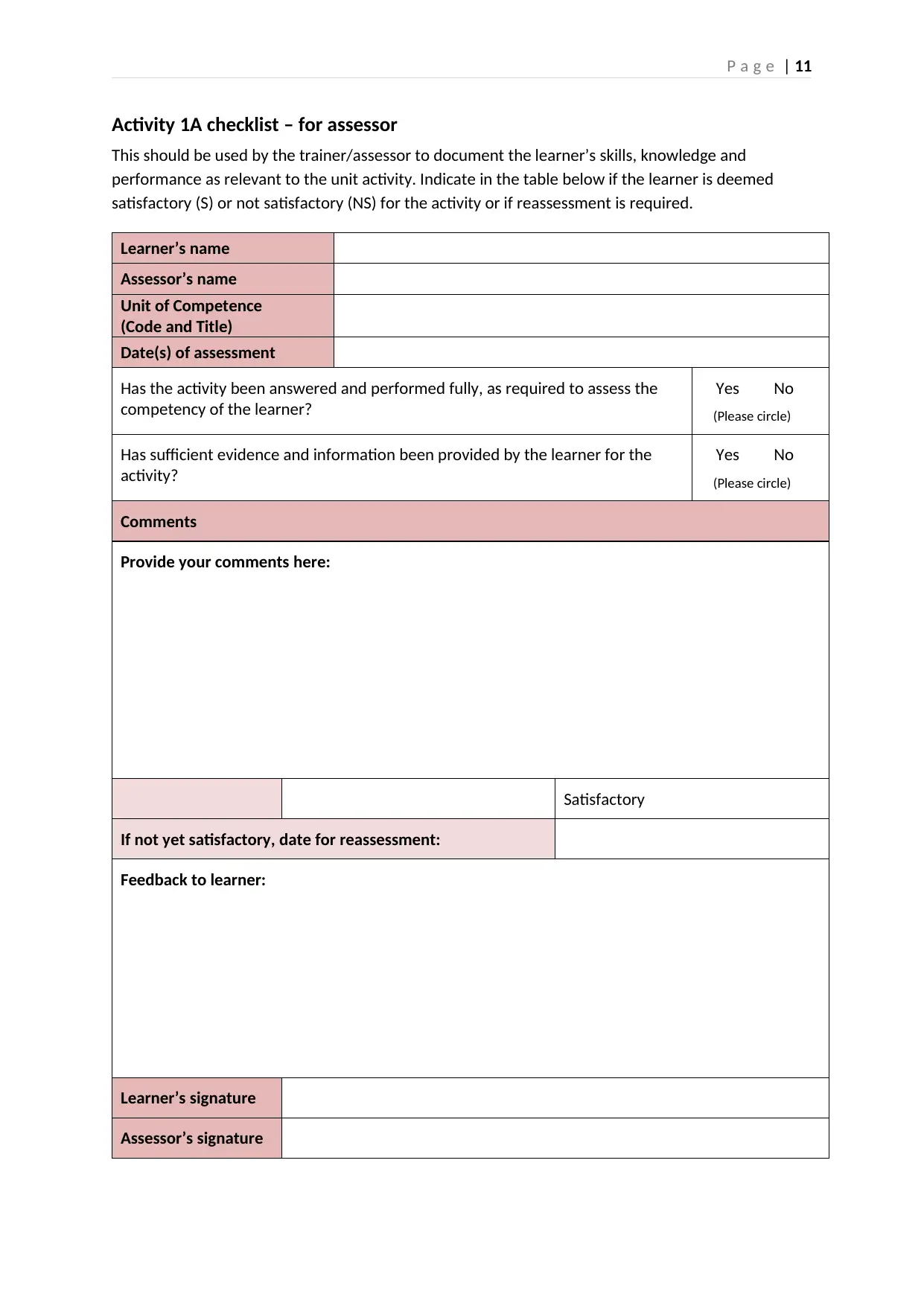
P a g e | 11
Activity 1A checklist – for assessor
This should be used by the trainer/assessor to document the learner’s skills, knowledge and
performance as relevant to the unit activity. Indicate in the table below if the learner is deemed
satisfactory (S) or not satisfactory (NS) for the activity or if reassessment is required.
Learner’s name
Assessor’s name
Unit of Competence
(Code and Title)
Date(s) of assessment
Has the activity been answered and performed fully, as required to assess the
competency of the learner?
Yes No
(Please circle)
Has sufficient evidence and information been provided by the learner for the
activity?
Yes No
(Please circle)
Comments
Provide your comments here:
Satisfactory
If not yet satisfactory, date for reassessment:
Feedback to learner:
Learner’s signature
Assessor’s signature
Activity 1A checklist – for assessor
This should be used by the trainer/assessor to document the learner’s skills, knowledge and
performance as relevant to the unit activity. Indicate in the table below if the learner is deemed
satisfactory (S) or not satisfactory (NS) for the activity or if reassessment is required.
Learner’s name
Assessor’s name
Unit of Competence
(Code and Title)
Date(s) of assessment
Has the activity been answered and performed fully, as required to assess the
competency of the learner?
Yes No
(Please circle)
Has sufficient evidence and information been provided by the learner for the
activity?
Yes No
(Please circle)
Comments
Provide your comments here:
Satisfactory
If not yet satisfactory, date for reassessment:
Feedback to learner:
Learner’s signature
Assessor’s signature
⊘ This is a preview!⊘
Do you want full access?
Subscribe today to unlock all pages.

Trusted by 1+ million students worldwide
1 out of 60
Related Documents
Your All-in-One AI-Powered Toolkit for Academic Success.
+13062052269
info@desklib.com
Available 24*7 on WhatsApp / Email
![[object Object]](/_next/static/media/star-bottom.7253800d.svg)
Unlock your academic potential
Copyright © 2020–2026 A2Z Services. All Rights Reserved. Developed and managed by ZUCOL.




